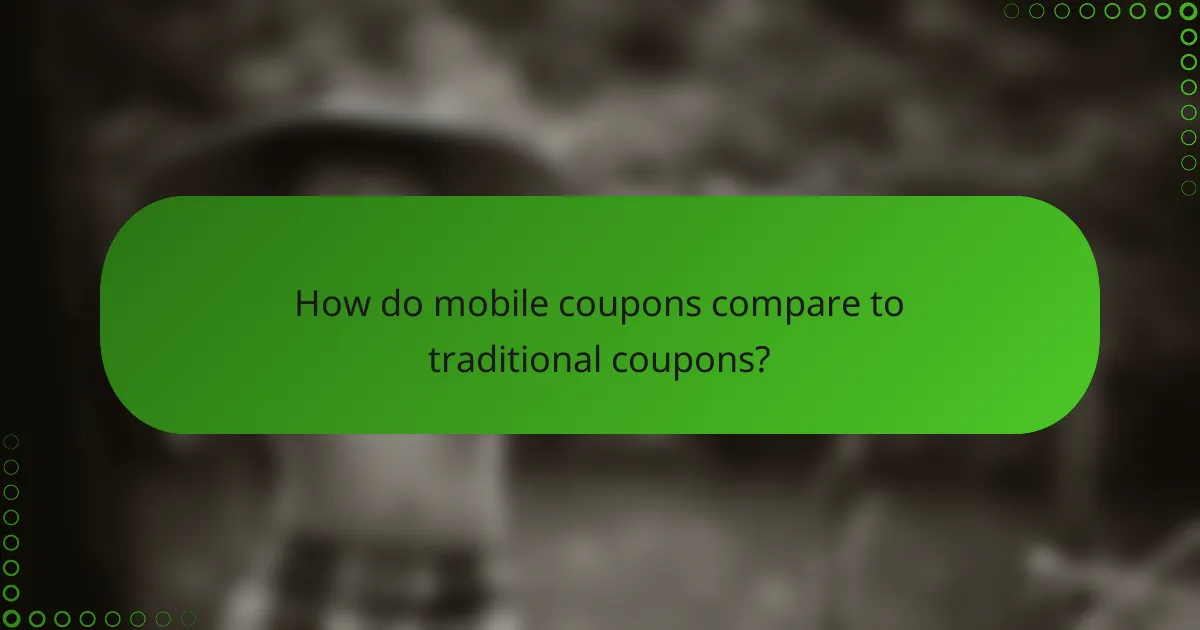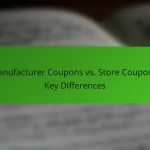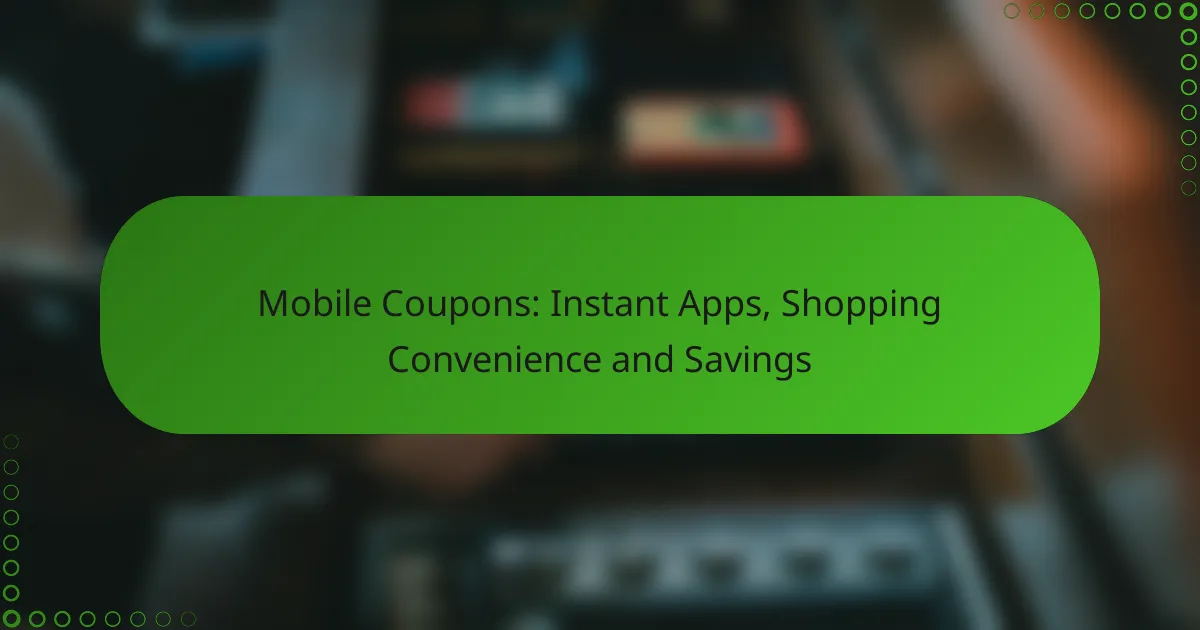In the evolving landscape of shopping, mobile coupons and traditional coupons each offer unique benefits that cater to different consumer needs. Mobile coupons provide unparalleled convenience and personalization, making them ideal for on-the-go shoppers, while traditional coupons maintain their appeal through physical presence and accessibility for a broader demographic. Understanding when to use each type can enhance the effectiveness of promotions and improve customer engagement.

What are the benefits of mobile coupons in the United States?
Mobile coupons offer several advantages over traditional coupons, particularly in terms of convenience, personalization, and engagement. They are easily accessible via smartphones, allowing users to redeem offers quickly and efficiently while on the go.
Convenience and accessibility
Mobile coupons can be stored directly on smartphones, eliminating the need for physical paper coupons. Users can access their coupons anytime, anywhere, making it easier to take advantage of discounts while shopping.
Additionally, many retailers have mobile apps that allow customers to browse available coupons and offers, streamlining the shopping experience. This accessibility can lead to increased usage, as customers are less likely to forget their coupons at home.
Real-time updates and notifications
Mobile coupons can be updated in real-time, allowing businesses to communicate new offers or changes instantly. This feature keeps customers informed about the latest promotions, ensuring they don’t miss out on time-sensitive deals.
Push notifications can alert users to special sales or exclusive offers, enhancing engagement and encouraging immediate action. This immediacy can drive foot traffic to stores or boost online sales significantly.
Personalized offers
Mobile coupons can be tailored to individual preferences based on past purchasing behavior or location. Retailers can analyze customer data to create targeted promotions that resonate with specific audiences, increasing the likelihood of redemption.
For example, a customer who frequently buys organic products might receive coupons for healthy food items, making the offers more relevant and appealing. This personalization can foster customer loyalty and enhance the shopping experience.
Higher redemption rates
Mobile coupons generally have higher redemption rates compared to traditional paper coupons. The ease of access and instant availability on smartphones encourages users to redeem them more frequently.
Studies suggest that mobile coupons can achieve redemption rates in the double digits, significantly outperforming the low single-digit rates often seen with printed coupons. This trend indicates that businesses can benefit from increased sales and customer engagement by adopting mobile coupon strategies.

What are the advantages of traditional coupons in the United States?
Traditional coupons offer several advantages in the United States, including their physical presence, broader demographic reach, and reduced reliance on technology. These factors can make them more accessible and appealing to certain consumer groups.
Physical presence and tangibility
Traditional coupons are tangible items that consumers can hold, which can enhance their perceived value. The physical aspect allows users to easily clip, collect, and store them, often leading to a sense of accomplishment when using them. This can encourage more frequent shopping trips as consumers actively seek out deals.
Additionally, the act of presenting a physical coupon at checkout can create a more engaging shopping experience. Retailers often display these coupons in-store, making them readily available to customers who may not have access to digital devices.
Wider demographic reach
Traditional coupons appeal to a broader demographic, including older adults who may be less comfortable with technology. Many consumers still prefer receiving paper coupons through mail or newspapers, as they are familiar and easy to use. This demographic often includes individuals who may not have smartphones or reliable internet access.
Moreover, traditional coupons can be distributed in various locations, such as grocery stores, community centers, and events, reaching consumers who might not engage with digital marketing. This strategy ensures that businesses can connect with a diverse audience.
Less reliance on technology
Traditional coupons do not require any technological devices, making them accessible to everyone. Consumers can use them without needing smartphones, apps, or internet connections, which is particularly beneficial in areas with limited technology access. This simplicity can lead to higher redemption rates among those who prefer straightforward shopping methods.
Furthermore, traditional coupons eliminate concerns about battery life or connectivity issues that can affect mobile coupon users. This reliability can encourage more consumers to take advantage of discounts without the fear of missing out due to technical difficulties.

When should you use mobile coupons?
Mobile coupons are best used when immediate access and convenience are priorities. They are particularly effective for promotions that require quick action or target specific consumer behaviors.
For time-sensitive promotions
Mobile coupons excel in situations where time is of the essence, such as flash sales or limited-time offers. These coupons can be delivered instantly via apps or SMS, ensuring that consumers receive them right when they need to act.
For example, a restaurant might send a mobile coupon for a 50% discount on meals valid for just a few hours. This urgency encourages quick decision-making and can drive immediate foot traffic.
When targeting tech-savvy consumers
Mobile coupons are ideal for reaching tech-savvy consumers who are comfortable using smartphones for shopping. This demographic often prefers digital interactions over traditional methods, making mobile coupons a more appealing option.
Brands targeting younger audiences or urban dwellers can leverage mobile coupons effectively. For instance, a clothing retailer might offer exclusive mobile discounts to customers who download their app, enhancing engagement and loyalty.
For location-based offers
Mobile coupons are particularly useful for location-based promotions, allowing businesses to send offers to consumers when they are nearby. This tactic can increase foot traffic and sales in physical stores.
For example, a coffee shop might use geolocation technology to send a coupon to customers within a certain radius, encouraging them to stop by for a discounted drink. This strategy not only drives sales but also enhances the customer experience by providing relevant offers at the right time and place.

When should you use traditional coupons?
Traditional coupons are best used in situations where digital access is limited or when targeting demographics that prefer physical formats. They can be particularly effective for in-store promotions and in areas where smartphone usage is low.
For older demographics
Older consumers often prefer traditional coupons due to familiarity and ease of use. Many in this age group may not be comfortable navigating mobile apps or digital platforms, making printed coupons a more accessible option for them.
When targeting older demographics, consider distributing coupons through newspapers, magazines, or direct mail. This approach ensures that the coupons reach those who may not engage with digital marketing channels.
In areas with low smartphone penetration
In regions where smartphone usage is limited, traditional coupons remain a vital marketing tool. These areas may include rural locations or economically disadvantaged neighborhoods where access to technology is restricted.
Using printed coupons in such areas can drive foot traffic to local businesses. Consider partnering with local stores to distribute these coupons effectively, ensuring they reach the intended audience.
For in-store promotions
Traditional coupons are particularly effective for in-store promotions, as they can be easily handed out or displayed at the point of sale. Customers can physically redeem these coupons, creating an immediate incentive to purchase.
To maximize effectiveness, consider offering time-sensitive discounts or exclusive in-store deals through traditional coupons. This strategy encourages customers to visit the store and make a purchase while the offer lasts.

How do mobile coupons compare to traditional coupons?
Mobile coupons and traditional coupons serve the same purpose of providing discounts, but they differ significantly in terms of accessibility, usage, and effectiveness. Mobile coupons are often more convenient and can lead to higher engagement due to their digital nature, while traditional coupons may appeal to consumers who prefer physical formats.
Redemption rates
Mobile coupons generally have higher redemption rates compared to traditional coupons. This is largely due to the ease of access and instant availability on smartphones, which allows consumers to redeem them at the point of sale without needing to carry physical copies. Estimates suggest that mobile coupon redemption can reach upwards of 10-20%, while traditional paper coupons often see rates in the low single digits.
To maximize redemption, businesses should consider integrating mobile coupons into their loyalty programs, as this can encourage repeat usage and increase customer retention.
Cost-effectiveness for businesses
Mobile coupons can be more cost-effective for businesses than traditional coupons. Digital distribution eliminates printing and mailing costs, allowing companies to allocate resources more efficiently. Additionally, mobile coupons can be easily updated or modified, reducing the waste associated with outdated paper coupons.
However, businesses should weigh the initial investment in mobile technology and marketing strategies against potential savings. A well-planned mobile campaign can lead to significant returns, especially if targeted effectively to the right audience.
Consumer engagement levels
Consumer engagement with mobile coupons tends to be higher than with traditional coupons. Mobile coupons can leverage notifications, reminders, and personalized offers, which can drive immediate action from consumers. This interactive nature keeps customers engaged and encourages them to take advantage of promotions more frequently.
To enhance engagement, businesses should utilize social media and email marketing to promote mobile coupons, ensuring they reach consumers where they are most active. Additionally, incorporating gamification elements, such as rewards for sharing or using coupons, can further boost participation.

What are the challenges of mobile coupons?
Mobile coupons face several challenges that can hinder their effectiveness. Key issues include technological barriers, user engagement, and security concerns, which can impact both consumers and businesses.
Technological barriers
Mobile coupons rely on smartphones and apps, which may not be accessible to all consumers. Older devices or limited internet connectivity can prevent users from receiving or redeeming these offers. Additionally, businesses must ensure their systems are compatible with various mobile platforms to avoid losing potential customers.
User engagement
Engaging users with mobile coupons can be difficult, as consumers often receive numerous notifications and offers daily. To stand out, businesses need to create compelling, targeted promotions that resonate with their audience. Personalization and timely delivery are crucial to capture attention and drive usage.
Security concerns
Security is a significant challenge for mobile coupons, as consumers may worry about data privacy and fraud. Businesses must implement robust security measures to protect user information and build trust. Clear communication about how data is used and secured can help alleviate these concerns and encourage coupon adoption.










